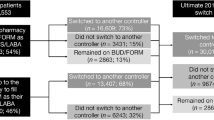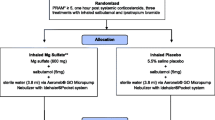Abstract
Essential inhaler medications for patients with respiratory diseases are backordered due to the coronavirus disease of 2019 (COVID-19). In hospitals, there has been a drastic increase in the use of salbutamol pressurized metered-dose inhalers (pMDIs), as well as salbutamol Diskus, leading to a decline in availability and causing interruptions in the supply chain. Patients with asthma are at higher risk of respiratory complications if they are infected with COVID-19. Salbutamol, a short-acting β-agonist (SABA), could be a life-saving medication during critical conditions. Other short-acting muscarinic antagonists (SAMAs), such as ipratropium pMDI, and combinations of SABA/SAMA, such as Combivent Respimat, are also starting to have supply issues. With the ongoing pandemic, hospitals need to consider conservation strategies to facilitate resource-efficient salbutamol delivery and reduce their waste. In this current opinion, we demonstrate several strategies for avoiding pMDI wastage that can be adopted in both the hospital and community settings. These strategies include reprocessing used or expired pMDIs, using intravenous salbutamol and other short acting inhalers when available, and prescribing maintenance inhalers to prevent over usage of salbutamol pMDIs. We also highlight the important role of physicians and pharmacists in optimizing medication therapies to ensure adequate supplies.
Similar content being viewed by others
Avoid common mistakes on your manuscript.
Salbutamol drug shortage
As hospitalization rates increase due to the spread of coronavirus disease 2019 (COVID-19), salbutamol has become the first line of defense for COVID-19 patients with respiratory distress in the emergency room [1]. Special populations, such as elderly patients with asthma or chronic obstructive pulmonary disease (COPD) and premature infants with compromised lungs due to the respiratory syncytial virus, rely heavily on salbutamol pressurized metered-dose inhalers (pMDIs). In addition, nebulization therapy, typically interchangeable with pMDI use, is not recommended in COVID-19 patients due to the risk of aerosolizing the virus and facilitating its spread [2]. Oral salbutamol (tablets and syrups) is not used for sudden breathing difficulties or asthma attacks. As a result, hospitals are seeing an increase in salbutamol pMDI use and supply has become limited. As a result of the current COVID-19 pandemic, salbutamol pMDIs, a staple therapy for millions of asthmatic and COPD patients with respiratory illness, are presently in short supply and on allocation [3, 4].
While the cause of this shortage is multifactorial, at the forefront is salbutamol pMDIs being prescribed and administered to a surging population of COVID-19 patients. Additionally, salbutamol tends to be used at high volume in ventilated patients, which is a complication of those diagnosed with severe COVID-19. In the community, the threat to salbutamol pMDI availability has been openly broadcast by media, and it is believed that there has been a level of personal stockpiling by individual asthma and COPD sufferers. With the pandemic forecasted to last for months, healthcare providers require conservation strategies in order to optimize salbutamol delivery and decrease its waste. Ultimately, a coordinated effort between health authorities, hospitals, clinicians, community pharmacies, and patients is needed to mediate the salbutamol shortage during the COVID-19 pandemic.
Conservation strategies to facilitate resource-efficient salbutamol delivery and reduce waste
Exploring the use of intravenous salbutamol
Hospital treatment of acute asthma exacerbations relies on pMDIs and nebulizers for delivery of short-acting β2-agonists (SABAs) and short-acting muscarinic antagonists (SAMAs) to the lungs, along with corticosteroids. Proper inhalation of inhaled medication is insufficient to reverse bronchospasms in patients who are unable to speak or breathe normally. In cases where pMDI cannot be used reliably, intravenous (IV) salbutamol is approved by Health Canada to treat asthma exacerbations that do not respond to inhaled therapy. However, evidence on the efficacy and effectiveness of IV salbutamol during COVID-19 is lacking [7, 8]. IV salbutamol should be given in a high-dependency unit with continuous electrocardiogram monitoring and twice-daily electrolyte monitoring for possible hypokalemia and serum lactate toxicity. Nebulized bronchodilators should be continued while the patient is receiving IV bronchodilators. Once the patient is improving, the IV infusion should be reduced before reducing the frequency of nebulized bronchodilators [9, 10].
Reusing pMDIs
There is considerable literature regarding the reprocessing and reuse of previously issued pMDIs. While a debatable practice, several hospitals have successfully implemented programs related to disinfecting the pMDI nozzle [11,12,13,14]. In one case, cultures were taken of the pMDI nozzle before and after disinfection with an alcohol prep pad, as well as after treatments were administered. Growth of Staphylococcus epidermidis occurred in roughly 5% of the cultures with all three types of specimens, including those taken after the nozzle was disinfected with an alcohol prep pad. In another case, the hospital assessed the failure to wipe the canister nozzle with an alcohol prep pad before patient use; one of 18 cultures (5.6%) resulted in the growth of streptococci group D (enterococci) [15, 16]. A multidisciplinary team of physicians, infection control experts, and pharmacists need to discuss the safest reprocessing protocols if pMDI reutilization is to be considered. Some studies have demonstrated steps to disinfect the pMDIs that prevent transmission of virus as well as growth of bacteria [17, 18].
Using expired pMDIs
It is routinely prohibited to use expired medication; however, given the current circumstances and the significant shortage of pMDIs, this practice may serve as a last resort. Most inhalers are safe to use for up to 12 months after the expiry date, which can be found on the packaging and canister. However, their effectiveness is not guaranteed once the expiration date has passed. Proper storage is essential for ensuring the pMDI is effective; it should be stored away from direct sunlight, high temperatures, and changes in humidity. When an expired pMDI is used in response to an asthma attack, it may not work as well as it should. The active ingredients in medications will break down over time. If a patient uses an expired pMDI in an emergency, they should switch to a new one as soon as possible. Therefore, we must educate patients about proper medication storage and the efficacy and safety of these medications beyond their expiry date. The use of expired pMDIs should only be considered when there are no other options available. Pharmacists should assess the risk and the benefit associated with use of expired MDI on a case-by-case basis (Table 1).
Take home messages
Drug shortages of life-saving inhalers continue to persist as the COVID-19 pandemic continues to spread. Nebulization therapy, the standard of care for bronchodilation in respiratory patients, generates aerosols, which increases the risk of droplet contamination that can remain in the air and can facilitate the spread of severe acute respiratory syndrome coronavirus 2 (SARS-CoV-2). Since the use of pMDIs reduces the risk of aerosol-generating particles, there has been a dramatic increase in the use of pMDIs during the COVID-19 pandemic. This has led to a decrease in the availability and a break in the supply chain of salbutamol pMDIs.
Hospitals should employ strategies to conserve supply and decrease waste throughout a patient’s hospital stay (Fig. 1). With regard to salbutamol pMDIs, such strategies include:
-
Having patients use their own pMDI
-
Reusing pMDIs after sterilization
-
Using nebulized salbutamol in COVID-19-negative patients
-
Counseling patients prior to discharge on the importance of using their maintenance inhalers daily and define the appropriate amount of medication to have on hand to prevent excessive usage of salbutamol pMDIs and stockpiling at community pharmacies
Amid COVID-19, pharmacists should collaborate with physicians to make decisions on the most optimal salbutamol dosage form for the patient—nebules, IV infusions, or pMDIs. Further research is needed to refine the reprocessing of used pMDIs to minimize contamination risks.
References
Government of Canada. Coronavirus disease (COVID-19): summary of assumptions. https://www.canada.ca/en/public-health/services/diseases/2019-novel-coronavirus-infection/health-professionals/assumptions.html. Accessed 21 Apr 2020.
Hui D, Chow B, Chu L, et al. Exhaled air and aerosolized droplet dispersion during application of a jet nebulizer. Chest. 2019;135(3):648–54.
US Food and Drug Administration. Drug shortages response: COVID-19. https://www.fda.gov/drugs/coronavirus-covid-19-drugs/drug-shortages-response-covid-19. Accessed 30 May 2020.
Drug Shortages Canada. Drug shortages homepage. https://www.drugshortagescanada.ca. Accessed 30 May 2020.
Green RH, Brightling CE, Pavord ID, et al. Management of asthma in adults: current therapy and future directions. Postgrad Med J. 2003;79(931):259–67.
Mayo Clinic. Asthma. https://www.mayoclinic.org/diseases-conditions/asthma/diagnosis-treatment/drc-20369660. Accessed 11 Apr 2020.
Boeschoten S, van der Crabben R, Boehmer A, et al. A loading dose of IV salbutamol in an adolescent with severe acute asthma and cardiac arrest. Case Rep Pediatr. 2019;2019:5057390.
Browne GJ, Wilkins BH. Use of intravenous salbutamol in acute severe asthma. Anaesthesia. 2003;58(8):729–32.
May C, Paterson J, Spiro S, et al. Effect of intravenous injection of salbutamol in asthma. Br J Clin Pharmacol. 1975;2(6):495–501.
Grissinger M. Shared metered dose inhalers among multiple patients: can cross-contamination be avoided? P T. 2013;38(8):434–42.
Institute For Safe Medication Practices. Revisiting the need for MDI common canister protocols during the COVID-19 pandemic. https://www.ismp.org/resources/revisiting-need-mdi-common-canister-protocols-during-covid-19-pandemic. Accessed 30 May 2020.
Government of Ontario, Ministry of Health and Ministry of Long-term Care. Joint statement: COVID 19 and health and safety measures, including personal protective equipment. http://www.health.gov.on.ca/en/pro/programs/publichealth/coronavirus/2019_covid_joint_statement.aspx. Accessed 30 May 2020.
MDIs: can cross-contamination be avoided? ISMP Med Safe Alert. 2009;14(7). https://www.medscape.com/viewarticle/702676. Accessed 29 May 2020.
Special edition: medication safety alert! April 3, 2020. ISMP Acute Care. 2020;25(6 Suppl). https://ismp.org/acute-care/special-edition-medication-safety-alert-april-3-2020/covid-19. Accessed 29 May 2020.
Teva-salbutamol HFA inhalation aerosol. Product monograph. Toronto: Teva Canada Limited; 2018.
Gregory KL, Wilken L, Hart MK. Pulmonary disease: aerosol delivery devices. 3rd ed. Irving: American Association for Respiratory Care; 2017.
Elbeddini A, Yeats A. Amid COVID-19 drug shortages: proposed plan for reprocessing and reusing salbutamol pressurized metered dose inhalers (pMDIs) for shared use. Drugs Ther Perspect. 2020;36(7):300–2.
Elbeddini A. Sterilization plan of the used metered dose inhalers (MDI) to avoid wastage amid COVID-19 pandemic drug shortage. J Pharm Policy Pract. 2020;13:19.
Author information
Authors and Affiliations
Contributions
AE was responsible for the concept and data curation. AE and LY were responsible for data collection and analysis of the paper. AE, LY, and YT searched the literature and wrote, reviewed, and edited the manuscript.
Corresponding author
Ethics declarations
Funding
No financial support was received for this work that could have influenced the outcome.
Conflict of interest
The authors have no relevant conflict of interest.
Rights and permissions
About this article
Cite this article
Elbeddini, A., Tayefehchamani, Y. & Yang, L. Strategies to conserve salbutamol pressurized metered-dose inhaler stock levels amid COVID-19 drug shortage. Drugs Ther Perspect 36, 451–454 (2020). https://doi.org/10.1007/s40267-020-00759-1
Published:
Issue Date:
DOI: https://doi.org/10.1007/s40267-020-00759-1





